#the glyphs translate to
Text

Headcannon that Entrapta isn’t always up for close physical touch, but will still hug people with her hair when she’s excited. Mostly about research findings.
Timelapse below cut.
#fanart#she ra and the princess of power fanart#she ra and the princesses of power#entrapta#hordak#entrapta fanart#the glyphs translate to#entraptdak#and#gay gay homosexual gay#in case anyone was curious#and reading this far into the notes
145 notes
·
View notes
Text
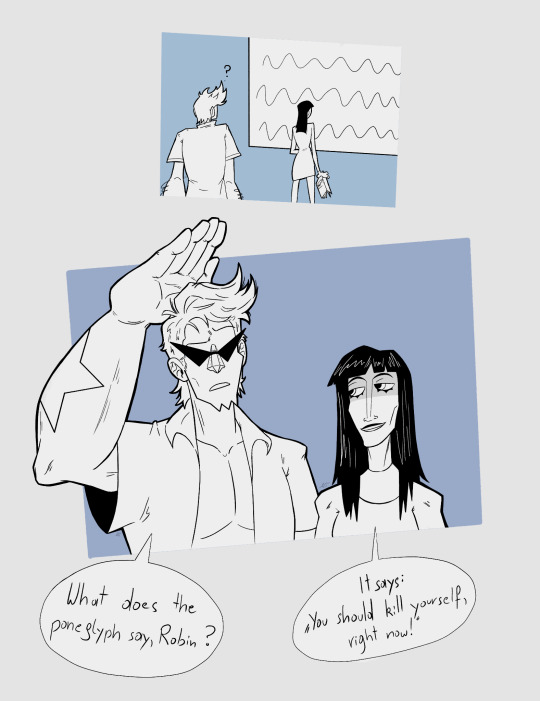
It just feels like something she'd pull, ngl
#one piece#op#nico robin#franky#franky op#I just finished thriller bark I'm doing great#my friend said that the glyph she jokingly translates here was probably one left by Roger#he's so real for that honestly that WOULD be in character for him#my art#fanart
70 notes
·
View notes
Text
WAIT A MINUTE!!!
in What Do You Say when Tom is like "nah I'm shopping for myself" and proceeds to be super awkward, it reads like just a normal goof in a fumbling, tripping-over-your-words conversation with an estranged ex you still have feelings for because we know he IS there for his kid, he said as much before. getting this toy for Tim is the whole point of him going to the mall.
but while listening to this for the ???th time, i realized he really IS shopping for himself! he only thinks it's for his kid because Wiggly's weird hypnotism/influence is telling him to want the doll, and that's how his mind is rationalizing it—he wants, no, he NEEDS this toy, so it must be for his kid, because why else would he want one? but it's really for him.
So I figure his "I'm shopping for himself" is either a mistake on his part that does some clever foreshadowing, or it's him still feeling close enough to Becky to be honest with her about it (while also doing some clever foreshadowing), which is honestly pretty cute, even if he immediately gets self conscious and awkward about it, lol.
#i have been listening to my hatchetfield playlist while doing some glyph translations and in the middle of all of that#i heard this line and my brain just went >:0 so i had to stop that and make this post lmao#(the glyphs are mine for a story im writing. making a code/language thing.)#anyway.#if everybody else already put this together uhhh pretend im new here so i don't feel dumb lmao#jack jabbers#hatchetfield#starkid#team starkid#black friday#black friday musical#tom houston#becky barnes#wiggly
103 notes
·
View notes
Text
Not only does Simon get to live his life now feeling fulfilled and accepting his existence and worth. But Betty gets to move on. her wish is fulfilled. She has forgiven herself, she has forgiven Simon. She’s saved him and now she’s being reincarnated restarting free to make new decisions hopefully with the lessons of this existence etched into her bones. perhaps in the calm and comfortable life on and apple orchard.
#saw someone saying the glyphs translate to comet#Betty becoming apart of the cycle of the universe#yeah absolutely she is#most important woman alive#i love her#adventure time#adventure time fiona and cake spoilers#adventure time fionna and cake#fiona and cake#fionna campbell#betty grof#simon petrikov#golbetty
147 notes
·
View notes
Text
just beat chants of sennaar! beautiful game
#i really enjoyed the translating between peoples bits the most#especially cause there were (obviously very simplistic) grammatical differences that i loved figuring out#my favourite translation was having to use the same word for devotees and the actual literal monster when talking to the warriors.#yeah guys you say u can handle it but i think the danger of the situation was lost in translation#very good game#chants of sennaar#and the ending was wild#it took me abt 8 hours to complete! and i got every glyph! (even though i nearly missed 3 from the alchemists)#cause i literally didn't need them to progress to the next level#but i went back n found em
12 notes
·
View notes
Text
Creating Mayan Glyphs Using Blender - AI Training Data

While there are plenty of images of real-world Mayan glyphs, many of these are not in publicly available database systems. Therefore, in order to create a Mayan Glyph translation tool that can work in real-world, carved and moulded, settings you need to get creative.
I first created M-AI-AN a couple of years ago using convolutional neural networks to classify basic single form glyphs. It was successful, but was limited to black and white/greyscale images of printed glyphs.
Now, after a few years experience under the belt, I thought it would be good to try again. This time, thanks to the power of masking modifiers, and the Python control line, in Blender - plus the use of transformer models to make multi-glyph classification a walk in the park. @roxcake - you will be happy to know that the model uses distinct square "patches" of the image to help classify, now using multi-head attention instead of 5 seperate CNNs.
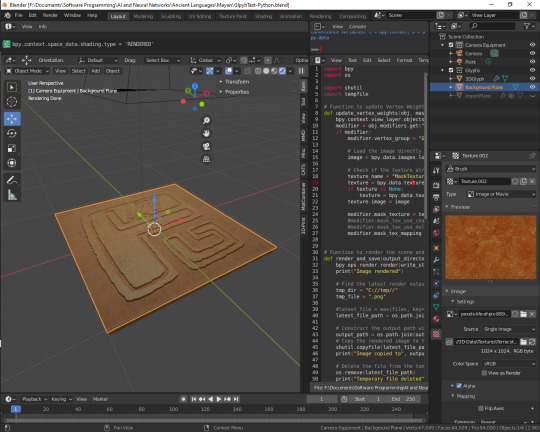
Essentially, a 3D setup is used to create a vertex mask on to a plane, with glyph images in pure black-and-white format:
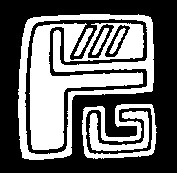
The Python script then effectively reads all of these images from a folder, and iterates across all of them, saving them into a specified folder - ready to feed the machine.
I am currently considering changing the light source location and image textures at random as well, but due to the number of glyphs I create with the multi-affix system, it isn't feasible to create multiple iterations per glyph without destroying my hard-drive!
2 notes
·
View notes
Text
What I was expecting when I started this little project: lots of interesting motifs to draw, having to figure out symmetry in odd objects
What I was not expecting: archaic Sumerian pictograph and proto-cuneiform deep dive
#christ ive been doing nothing but learning about sumerian writing systems all morning#project is neathy coins btw sjdbksbs this is specifically for the 'untranslatable script' on the backs of first city coins#(translates your untranslatable glyphs) hehe#but seriously its a nightmare. we do not know much about writing systems that old i am working primarily off of like#three different reference images of archaic sumerian and hoping to get something roughly correct#AND im having to make symbols that seem accurate but arent for thinfs like the bazaar#anyways my brain is melting. category five coin and language based autism moment. im thriving
4 notes
·
View notes
Text
Since I need to distract myself from last episode's angst, here's some thoughts about bard magic : Since Eda seems to be able to use bard magic despite her curse (it's all messed up, but the magic is there, even if it's corrupted), what if bard magic doesn't necessarily require a bile sac ? I remember Lilith describing glyphs as some kind of language, glyphs combos being like sentences. What if glyphs could be translated into music ? Imagine a music sheet made of glyphs !
Also, bard magic seems very close to the effects of the light glyph. When Eda uses it, it create some kind of lighting and levitation effect, and when Raine is fighting with their magic, it seems to create light waves. The light glyph maybe is like a treble key.
Of course the bile sac probably helps, but I wonder if Luz would be able to perform at least basic bard magic if playing an instrument in the Isles, without even needing glyphs. Instead of being in a snowflake, the glyphs would be hidden in the sound waves.
-
Il faut encore que je me remette de ce qu'il s'est passé dans le dernier épisode, du coup voici une théorie sur la magie de barde : Puisqu'Eda semble capable d'utiliser la magie de barde malgré sa malédiction (L'effet est détraqué, mais la magie est bien là, même si elle est corrompue.), et si la magie de barde ne nécessitait pas forcément un sac de bile ? Je me souviens que Lilith a comparé les glyphes à un type de langage, les combos de glyphes seraient en fait des phrases. Et si les combos de glyphs pouvaient être retranscrits en notes de musiques ? On pourrait faire une partition écrite en glyphes !
La magie de Bard semble aussi proche du glyphe de lumière. Quand Eda l'utilise, cela créé une sorte d'effet de lumière en plus de la lévitation d'objets, et quand Raine utilise sa magie en combat, iel fait des ondes lumineuses. Le glyphe de lumière serait comme une clé de sol.
Le sac de bile aide sûrement beaucoup, mais je demande quand même si Luz pourrait faire de la magie de barde, même basique, juste en jouant d'un instrument et avec la magie du Titan, sans glyphes. Au lieu de se trouver dans un flocon de neige, les glyphes se cacheraient dans les ondes sonores.
#the owl house#toh#bard magic#raine whispers#eda clawthorne#glyphs#theory#magic#french translation#thoughts
14 notes
·
View notes
Text

this came to me in a dream and i felt the need to construct it to present in real life
(the glyphs actually DO say words. i think it was inspired by a tumblr post i can’t find, but i don’t know. how my brain generates images is a complete enigma)
#meme#frankly i'm not even sure i can classify it as a meme#i still don't understand half of what's going on here myself#yes all the glyph fonts translate to creature
15 notes
·
View notes
Text


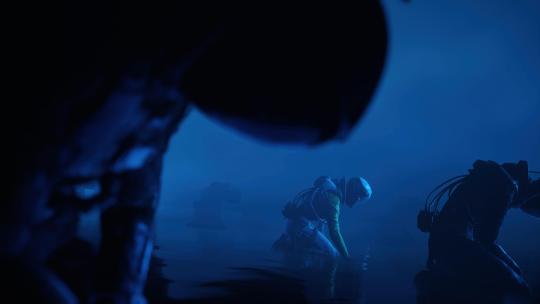

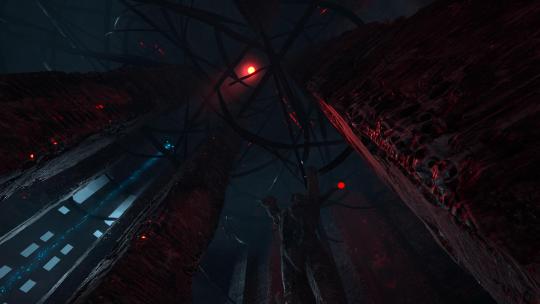
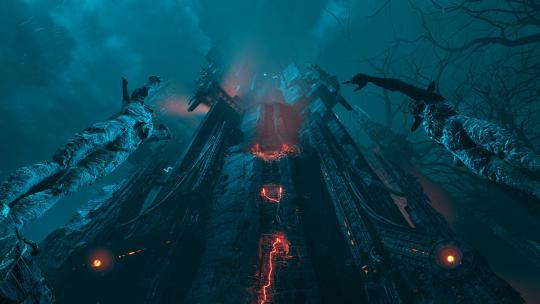

Finally beat the Returnal DLC so have some screenshots :D thought the story couldn't get more devastating but I was wrong :))))))))
#I love the aesthetics of this game so much#wish they would release an art book#it's so creepy and pretty#now i'll just have to spend another 50 hours to collect the last 5 or so scout logs I missed because I need them#plus the few glyphs i'm missing so i can get the correct translations for yet further trauma :D#text posts by thea#thea plays returnal
2 notes
·
View notes
Text
Chants of Sennarr is taking over my LIFE
When I was falling asleep last night I was really busily constructing a hypothetical scenario in which I as the Traveler was talking to a Bard and a Warrior and trying to get them to learn each others language. And I was talking in Warrior language and Bard language both to bridge the gap between them, but mostly warrior because I'm more familiar with it.
In the process I realized warrior doesn't have a glyph for "you" so I combined the glyphs for "impure" and "scientist" becaue those are the groups I identify with most, and made that my name. (I consider traveler-me to be a devotee because that's where I woke up and it's the language I know the best, and also a scientist because the scientists are helpful and friendly and did most of the work in opening the door to the next level.) My name in Bard was the glyphs for "monster" and "beauty", because they don't even have a word for the impure, so monster works and I lean towards being not human anyways, and then beauty because I wanted to combine a good thing with the bad thing and the Bards would find the contradiction appealing. Also in recognition of the fact that the Traveler never talks, I was using my notebook to write things down, and also an interface similar to the conversation doors where I could select glyphs and they would appear in a spot on the wall.
The way I was teaching the bard and the warriors each others language was I would write in my notebook "warrior '[warrior glyph]'" and underneath it "warrior '[corresponding chosen one glyph]' and then I would jab more finger at the page until warrior said it. In bard language I would write "'[bard glyph]' you bard talk" and "[warrior glyph]' you warrior talk". I'll be real though, I don't think they learned too many words. I got distracted by talking to the warrior because Bard language still is difficult for me to plan out and speak. I did have plans of writing out a map of the directly translatable glyphs though! Even if Warrior doesn't have me, you, be, or compass, and even if Bard doesn't have instrument, crate, or big/small (I'd translate instrument as "music weapon" btw), about half of their languages directly correspond to each other. I could just copy over my written down glyphs and draw lines between the ones with similar meanings.
#all me#chants of sennarr#cos#not tor#also while in the half-dream I realized that there is no way to express “alone” “good” “bad”or “happy” in either language#and I really struggled with expressing that I was glad I wouldn't be alone anymore because other people could learn the languages#and talk to each other#and it wouldn't be just me skulking through the dark anymore#also nobody has Any words for time what's up with that??#not even past present future? Come On#how are we supposed to make plans without that :/#to summarize: if anybody is interested in chatting with me via all the different languages or if you have glyph fonts hmu#oh i guess in Warrior you could translate “bard talk” as “chosen ones music” not perfect bc “talk” is a verb while “music” is a noun#but still gets the idea across I think#chants of sennarr spoilers#cos spoilers#oh btw guys I haven't finished the game yet so no spoilers#i've met all the people and im going through the tower doing [redacted] so im pretty late game but haven't finished it
1 note
·
View note
Text
Give me a sentence to make into gem glyph!
I will doddle a Sapphire saying it.
Please keep sfw.
0 notes
Text

alhaitham x eremite!afab!reader
wc: 1.2k
genre: nsfw with a dash of pet names, light exhibitionism, and creampie bc wtf not
summary: guess you better look under the cut and find out for yourself huh?

You hated Alhaitham.
You hated his dismissive attitude, his condescending tones and sharp replies.
You hated how good he was at manipulating people, how easily he could get what he wanted with minimal effort, how perfectly he had constructed his life and career to cater to his every tiny whim while having the audacity to act bothered.
But what you hated the most about him?
How easily he had got your name added to a group of Driyosh heading to investigate the Khaj-Nisut.
How he knew you wouldn’t refuse the chance and that you would be indispensable in their search for more information on King Deshret’s tomb as you were from a proud Eremite clan.
How easily he had split you away from the rest of the group under the guise of watching your interpretation of the glyphs carved into the walls.
How quickly he had cornered you in the quiet of the abandoned Throne room of King Deshret, and how effective he was at making your body betray itself.
“Shhh, you don’t want them to find you like this now do you?” He chided in your ear. Some part of you despised how calm his voice sounded now, yet that little gripe died quickly at the hand of his ministrations that left you quietly gasping, back arching against his chest as his thick fingers pumped into your pussy.
Your skirt was hiked up past your ass, your panties soaked through with the juices he coaxed out of your body. Your tits spilled out of your blouse, nipples peaked from the chill of the crypt that was a harsh contrast to the hot breath of the Scribe which fanned over your neck as he trailed wet kisses down the column of your throat. Your entire body trembled as he inserted another finger, his long digits curling deeply inside your walls, probing for that spongy spot that would have your knees weak and your head fuzzy from ecstasy.
He knew the exact moment he found it, your body stiffening with a gasp as your hands braced tightly to his arms, as if trying to fight him away from your most intimate places. He didn’t budge, fingers curling into that spot where he could feel your gummy walls clamp tighter around his fingers, his thumb venturing up to roll your clit under its pad.
“Haitham!” You choked out, jerking in his arms as your hips tried to flee from the onslaught only to end up pressing deeper into his own, feeling the stiff outline of his cock straining in his pants against your ass.
So badly you wished you could control your body, yet the foggy haze settling into your brain spurred you on to chase the high that was riding the fingers of the Akademiya’s Scribe in the throne room of the god of your people. Surely you had relinquished your spot in heaven now, hips rolling in an attempt to stimulate yourself further on his fingers.
You could feel a chuckle reverberate through his chest. “You like that, princess?” He mused, rolling your clit in tight and harsh circles, thriving for how your mouth fell open so dumbly, how you begged for his attention, for the breathy gasps of his name already falling from your kiss bitten lips.
A loud clatter snapped both of you back to reality, both freezing in place despite the compromising position you stood in and listening closely to the little sounds that traveled up to the private sanctuary you were in from the larger chambers below. Your walls clamped tightly upon his fingers from your surprise, the mounting distress of the situation only tightening the knot coiling in your stomach.
The voices of the rest of the research team were muffled by the countless stone walls between you, but you could still make out their words. They were bickering about translations, how they really needed to find where you and the Scribe had ventured off too because surely one of you would know the correct answer.
“Did you hear that, princess? They’re looking for us, guess we better hurry things along.” Came Alhaitham’s warm, breathy laugh against the shell of your ear. You shuddered, yet mustered the most hateful tone you could as you forced his fingers out of your weeping cunt and rounded on him, jabbing a finger into his chest.
“Oh, think you have it in you, feeble scholar?”
Dual-colored eyes bore into you for a moment, as if sizing up your challenge. “Feeble as I may be,” he relented, raising his hand still sticky with your fluids, spreading his fingers before your eyes as the viscous liquid slowly seeped down towards his covered knuckles, “someone has to take care of this.”
And take care of it he certainly had.
You had kissed every semblance of heaven goodbye. It wasn’t for you anymore. You were perched on the lap of a man not native to the desert, your legs hooked over his thighs and spread widely enough to take him as he bounced you on his cock while sitting on the throne of the dead god of your people.
The wet, slapping sound of sex filled the chamber, echoing back to your ears as Alhaitham bullied your pussy until you had gone dumb in his arms, babbling quiet nonsense while your pussy worked diligently over his intruding length.
You couldn’t count the times you had been taken to the edge of an orgasm only to be overstimulated into the next, a ring of tears lining your lashes from the pleasured cries you had worked so desperately to muffle as to not alert your fellow researchers who’s voices you could hear growing slowly closer to your location.
“I’m close.” Alhaitham warned, giving your clit a sharp pinch as you gasped aloud. His chest pressed against your back, bending you nearly in two as he fucked into you with a new fervor. You could feel the press of his thick cock in your womb, its leaky head ramming into your cervix as you cried his name like a prayer. That coil in your gut he had worked so diligently to form snapped with a sudden white heat, your mind going blank save for the pleasure rolling through your veins like molten metal.
Alhaitham let out a choked noise as your pussy tried to milk him of his seed prematurely, continuing to fuck into you till his own pace stuttered. He bit down onto your shoulder, and with a deep groan gave in to your biological response.
You felt so full it could have driven you crazy as you shakily righted yourself, cringing from the overstimulation of his re-hardened cock against your walls. Your eyes ventured to where you two were connected, a creamy ring having formed at his base of his cock.
You went to rise only for him to catch your hips. “Don’t move.” He hissed as he forced you back onto his cock, a whimper leaving your lips as you squirmed. Despite having barely lifted yourself off of him you could feel the cum sitting deep in your womb shift down with the absence of his cock, the fluid leaking out of your pussy. Your eyes widened, watching as it leaked onto the seat before pooling and running down the face of the throne.
You were totally screwed.

Rey, 2023
#genshin impact x reader#genshin impact x you#genshin alhaitham x reader#alhaitham smut#genshin smut#i’m sorry lol#al haitam x reader#genshin imagines#genshin impact
984 notes
·
View notes
Text
The Immigrant and the Colonizer
There’s something fascinating to me about the juxtaposition of Luz as the immigrant, and Belos as the colonizer; The whole interplay of the outsider coming into a different world. The Wittebanes and Nocedas both came to Gravesfield, but the Wittebanes have the historical context of being part of a larger colonial movement that sought to exploit the Americas; By contrast, the Nocedas are of Dominican heritage, meaning somewhere along the way, they immigrated to the U.S.
So you have Philip participating in this colonization in order to be on the better end of the power dynamic, making the outsider status into one of oppression and dominance, and this naturally translates to how he interacts with the Boiling Isles and bastardized everything about it for his own ends. Conversely, you have the Nocedas, who given their backgrounds, are inevitably submitting themselves to the power structures that Philip was a part of and represents.
Which means with the Nocedas, it’s the outsiders who are the ‘mercy’ of the world they’ve traveled to, and they’re the ones who are pressured into assimilating into it, being measured by Gravesfield’s standards of what a proper citizen should be, etc. Camila hides parts of herself deemed 'undesirable' and even ironed her hair flat. If the Wittebanes came to dominate, the Nocedas were made to submit.
And this just ties into Luz maintaining her own identity and still holding onto that, as do Manny and Camila. The Nocedas ultimately understand that they can’t lose themselves to be a part of something, and I find that ties in nicely with the whole interplay of wanting to be your own person, but also wanting to participate, and balancing these two things; Otherwise you end up like Eda, who for a while was a lonely outcast, or Lilith, who conformed but at the cost of so much.
What’s also interesting is that Luz is afro-latina; Meaning she’s the descendant of those brought over as part of the colonization effort, whether they wanted to participate or not, and the natives indigenous to the Americas. So there’s Luz once again navigating two worlds as the immigrant and the native.
So amidst the Nocedas learning to maintain their identities in a foreign world, we also have Luz learning to engage with another one in the Boiling Isles, and this is where she differentiates from Philip; She does not become entitled to this world. She recognizes by the second episode that this world and its people do not exist to cater to her whims and fantasies; If she wants to really participate, Luz needs to put in the effort to actually engage with the Boiling Isles. And with Adventures in the Elements, Luz understands that it’s not just about engaging with the isles, but engaging with it on its own terms; She realizes she can find the glyphs in nature after learning to commune with it, in the form of the Titan. And nature will respond to Luz if she shows respect.
There’s a lot to be said about how Luz worries over whether she’ll be a ‘real witch’, and how this can parallel how immigrants in general can feel like outsiders who don’t really belong, who don’t actually partake in this local identity; There’s a parallel to real life about a white Puritan immigrating to another land, only to colonize and make it hostile to a future Latina immigrant, all while his own double standard is left unacknowledged by his government (“Go back to your world” as said by Lilith during her time in the Emperor’s Coven). But in the end, Luz manages to figure out witchhood on her own terms, while co-existing healthily with the Titan and the people around her.
And it’s not as if this quality of respecting the land and its people is inherent/unique to people of indigenous heritage, either; We have Caleb Wittebane, a white man who initially was a part of the colonization of the Americas. But as Caleb’s story proves, he is not doomed by ‘race’ or ‘genetics’, he can choose to learn and respect different worlds and people, unlike Philip, whose ravings on humanity needing to be saved from witches and demons boils down to bioessentialism. Caleb falls in love with Evelyn, he unlearns what he was taught, and he even becomes a part of this other culture by having a mixed child, from whom Eda and Lilith are descended from.
The Clawthornes are unambiguously witches and people of the isles, despite their human ancestry; Mixed race people are often accused of not really belonging to either race, which again connects to Luz and how she worries about being a real witch and not belonging in the Demon Realm, even as she struggles to fit into the human world, and of course her Afro-Latina identity. Because in the end, yes; These ‘outsiders’ CAN and should engage with other cultures, and even become a part of them.
In discussing colonization and appropriation, a lot of well-meaning people have fallen into the trap of acting as if there’s some inherently, morally wrong about white people, and just outsiders in general, engaging with a culture different from theirs; And this is just segregationist rhetoric, but reworded to sound progressive. Because discouraging people from connecting to and learning to understand those unlike them is actually a bad thing that contributes to prejudice. And that’s the importance of Luz and Caleb, with Caleb especially proving that white people have no excuse NOT to be respectful; In death, his pose mirrors that of the Titan’s, signifying him as someone who understood the spirit of the world.
Fascism and racism in general relies on the premise of Us VS Them; But with how Belos is the colonizer, it’d be easy to fall into the trap of saying that humanity and witches should be separate, period. But that just risks casting humanity, or even just white people, as separate and inherently different (and thus excuses a supposed inability to connect with Us). And yet you have Luz, who is also a human outsider like Belos, and while Belos causes no shortage of problems, Luz herself is a solution who changes so many people’s lives for the better; Outsiders have a lot to offer, actually!
And that just goes back to the key distinction between the immigrant and the colonizer, the one who imposes, and the one who assimilates. There’s the blurring of the distinction that is categories, and the questioning of the binary, as Luz CAN still maintain a connection to her human heritage and home, while becoming a part of the Boiling Isles. She doesn’t have to abandon one for the other.
Likewise, we don’t know much about Caleb’s process in acclimating to the isles, but it’s worth noting how he abdicates the power dynamic of the colonizer to become a part of something else. Maybe this is assimilation, but maybe it’s not, because Caleb is doing this on his own terms. And given his joyous reaction to Philip, and assumption that he was here on good terms? I think Caleb would’ve gladly maintained ties to his human heritage, if the humans he knew weren’t explicitly rejecting co-existence and making it impossible for him to do that.
But as Caleb himself, and finally the Nocedas prove, it’s not actually necessary to maintain this segregation just to maintain one’s own identity (Caleb doesn’t hide his ears). Even Caleb’s descendants in Eda and Lilith understand it; You can be a part of something and still be your own person. Luz can still make new connections and become part of a new world without having to renounce her heritage. These things aren’t inherently contradicting one another, it’s only the belief that they do. But you can choose to make things work and adapt, just as Caleb and especially Luz did.
Yeah, an outsider spelled doom for the isles, but an outsider was also the one who saved them. By principle, the isles should still be open to others, hence Gus facilitating contact with his exchange program. Gus is deeply fascinated by human culture, he gets to visit its world, but he also misses his dad and home and gets to go back to that two, and now he gets to make them both meet; So the reverse to this human outsider to a demonic world also applies here.
We have Gus, but also Luz’s other friends, who adapt to the human world; Eda also applies, as someone unaware that she is technically REconnecting with her human heritage when pursuing her trash collection. And of course we have Vee, who becomes a member of the Noceda family we've been talking about, as someone also an immigrant who had to blend in to survive, and suffering the consequences of xenophobia.
There’s also the Archivists and the Collector; The Archivists came in to control another world, converting it into scrolls under their possession, under the claim of preserving and protecting things. And part of their plan relied on using the Collector as an unwitting Trojan Horse to lower the guard of the native Titans. You have the Collector genuinely loving the Titans and forming bonds with them, only to be made complicit in invasion; And when the Titan retaliated, basically under the assumption that all outsiders like the Collector were evil, it led to more tragedy. And the Collector, for all their love of Titans, still had to learn to respect them and their agency, as well as everyone else’s in the Boiling Isles.
Sure, there’s a potential risk to letting others in, both on a personal level, and on a larger one like how the Boiling Isles –particularly the Titan herself- let in others, such as the Archivists, and later Philip Wittebane. I wonder if her regret over mistreating the Collector led to her giving Caleb, and then Philip, another chance; But even when Philip backfired, the Titan still kept enough of an open mind to let in Luz afterwards, showing a sincere repentance for how the Collector was treated. They’re clearly capable and willing to learn, it’s not inherent to their species to dominate, any more than it is for white people like Caleb or Hunter.
And that takes us back to Gus; It’s like how he realizes with Hunter’s help that even if people will take advantage of your kindness and hurt you, in the long run, that welcoming acceptance is better for the world. You’re obviously entitled to resistance and self-defense if repeatedly exploited and hurt, but that doesn’t mean you’ll always have to. Colonization/assimilation IS a thing but it’s not the inevitable result of cross-cultural interaction, you can and should let different things coexist.
#the owl house#luz noceda#caleb wittebane#gus porter#augustus porter#boiling isles titan#emperor belos#philip wittebane#meta#analysis#themes
156 notes
·
View notes
Text
a linguist* plays chants of sennaar (pt 1)
*i studied linguistics for four years and concurrently did three years of sociolinguistics research, but i'm not currently employed in a linguistics-related field.
[pt 2] [pt 3] [pt 4] [pt 5]
thought i'd have some fun breaking down the languages in cos and stretch my rarely used linguistics muscles in the process! disclaimer: can't promise that i'll have any insights that a layperson wouldn't have, this is kinda just me thinking through the grammar of the language out loud haha.
this post covers the first language and will contain spoilers! it also assumes that you know what each of the symbols means already.

so the three glyphs from the devotee's language that you get introduced to right off the bat already tells me a lot: it's a pictographic logography (real life example: chinese characters), which is probably a good place to start for people who are new to language deciphering (also, none of these languages are spoken so an alphabet would be pointless lol). a logography is a writing system that represents whole words/concepts with a single character, as opposed to representing the sounds that the words make (like alphabets or syllabaries). i haven't completely finished the game yet (most of the way through the fourth language), but i'm p sure 1) all of the languages are logographies and 2) the devotee's language is the most true-to-life with its pictograms.
with these three words we can also begin to establish a pattern--verbs most likely have a line on the bottom, which holds true for the rest of the characters. i think the only exception to this rule is the character for "greeting", which is also used as the verb "salute" later in the game (an interesting choice (considering etymologies for greetings in irl languages), but it makes sense when your language is only 40 words lol). other patterns include the curved line for tools, the semi-open box for structures/locations, and the half-circle with the line for things relating to sight (which amusingly is also the overall game symbol for examining something). (not gonna include things like "man" and "music" and "plant" in this list cause they're defined in game.) i do think it's kind of fun that they introduced "i/me" and "you" before they introduced "man"—it validates that you'll find patterns haha.
(while writing the prev paragraph, it finally hit me that the symbol for "key" is open-tool. isn't that cool!)
i did notice at one point in the game that there was a devotee word that was cut off in one of the stone carvings that looked like it might have been the equivalent for "fortress"--it was the room radical with the two opposing arrows from the word for "warrior". although it's not validated by the game's automatic translation function, it does seem to be evidence that the language elements are fairly flexible and recombinable!
this language is SVO (subject verb object), like english, which again is a choice that makes sense in terms of easing people in. it uses reduplication with nouns to indicate plurality, which as far as i can tell is unique amongst the languages in this game. there's no tense markers, which is common to all the languages in this game (again, as far as i can tell without having encountered the last language yet). given how simple the languages in the game need to be, i'm not surprised that there aren't really auxiliary verbs or indications of infinitives either.
questions that still remain unanswered:
- "dead/death", "seek", and "find" all have dots that don't show up in the other characters. not sure why that's the case. could be a representation of something metaphysical?
- the character for "go/pass" has a "room" radical on the right side and something else on the left side. wonder if that was intentional
211 notes
·
View notes
Text
What are Hieroglyphs? - A Q&A from a Poll
I ran a poll last week to see what people most wanted to know about how Hieroglyphs and languages such as Old/Middle/Late Egyptian work. While certain responses had more of an interest, the most common tag/comment I was getting was 'umm all of them?'. So, I'm going to do just that, but under a cut, because no one needs a post that's going to be as long as this one is without choosing the colour of the sky. Trust me, this is colour of the sky long.
So, without further ado, these were the results of the poll (yeah it's not finished yet, really, but the percentages haven't moved in 4 days and the poll ends in about 12 hours so here we are):

I'll start with 'least interest' and move onto the bigger things, as some of these I can get out of the way pretty quickly. I'll apologise to screen readers in advance, because you might imagine how difficult it is going to be describe hieroglyphs in a way that makes any meaningful sense, especially if they're using different cultural concepts. So, here we go!
How long does it take to translate?
Honestly, it depends on the text, and to some extent the language I'm translating it from. For me, Late Egyptian is the easiest, so a text in Late Egyptian (with all that entails) is a breeze. Others will find Late Egyptian really difficult because that form of the language (used from the Amarna period onwards when the written language changed to reflect the spoken language...except on monuments and tombs which kept using Middle Egyptian) uses a lot of semitic loanwords and has differences in orthography (the way signs are laid out and spelt), as well as changes in grammar (moves to frontal exposition so all the markers come at the start of a sentence).
Once you're past the 'oh it's in a form of the language I like/hate' you're into 'what kind of bullshit is this text going to pull on me?' and that can be easy or nasty grammar, lots of spelling mistakes/no spelling mistakes, what kind of text it is like biographical (formulaic, tend to be easy) or literary (not formulaic, full of metaphors and strange sentence composition), or religious (formulaic, but *Chalmers pointing* Dear Lord what is happening in there?). You can get a formulaic biography that's nasty to deal with (Tjetji) or a 'I'm so full of metaphors that I can fight god' literary text that's actually pretty nice to deal with.
In any case, if we're talking about something longer than 5 lines of text we're talking hours to translate. It's not like the films where they just read it on the fly (though you can reach some level of that), you are going to need a notepad, a dictionary, and several hours. This obviously lessens the more experience you have.
Why are the signs so specific?
We're dealing with a language whose script communicates in what are essentially pictures with sounds. It's also an art form as well as a written script. This means that it can, through necessity, create a new sign to express something. More often than not, these signs are very specific, which means you don't see them all that often (hello religious texts again) or they've combined two signs together (overlapped them essentially) for space reasons and it's ended up as it's own sign eventually. I mean, if you had the ability between trying to use what you've already got, and drawing an entirely new sign that is literally a picture of what you want...you're gonna draw a picture. This is why you get the penis glyph. There was always going to be one because at least half the population has one. There are also tit hieroglyphs. Equal opportunities and all that. The tit ones have less applications though, sadly.
How do you remember all the values for all the signs?
I'm gonna be annoying and say: Practice
But it's true. Just like children learning to speak, it has to be repetition repetition repetition. The more you see it, the more you're exposed to it, the more likely you are to remember sign values. There are still some signs I have to look up because they never stick in my head, but mostly I'm able to transliterate very very easily. Once you've got sign values down, you're more likely to begin to recognise them in word groups, which means you're more likely to just know the words by sight. It is very much like learning to read. First you learn the letters T, H, & E, and then you learn that T, H, & E together spell the word 'the' and then you simply recognise the letter group as the word from then on. Same principle for hieroglyphs! Some people will be able to remember them effortlessly. Some people will never be able to remember them. It's all about how your brain works, so don't beat yourself up about it.
How do you work out the grammar?
*laughs nervously* erm....so y'know how I'm bad at remembering grammar? This is going to be a wild ride. In the simplest terms, there are markers within the Egyptian, just like we use certain endings (like '-ed' for the past tense or -ing for present action) or markers (! ? . , etc), so do the Egyptians. I'm not going to cover them all here because goddamn no one needs to know those unless they're actually learning the language and it would get LONG. But I'll show you at least the past tense, pronouns, some special markers called Particles, and prepositions.
Pronouns
Simple, yet important. These little guys come at the end of verbs (at least in Middle Egyptian). They have every pronoun we do except the singular 'they'. Now there are several different types of pronouns depending on whether they're the subject/object attached to a verb, or subject/object that are independent of the verb. This is where you get the 'suffix' (attached to the verb as the subject), dependent (not attached to the verb but related to it), and independent (come at the start of the sentence, not attached to the verb but still the subject. Usually Participial Statements have these). I'm only going to deal with the Suffix pronouns here because sweet jesus this is a whole chapter to itself in a normal grammar book and I'm not doing that. They look like this:
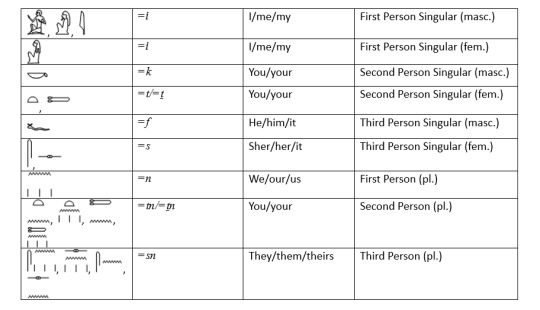
For other hieroglyph readers sake: I am of the school of hieroglyphs that uses =i instead of =j, and I don't use z for one of the s signs. That's why you're seeing that difference.
For the rest of you: Sometimes there are variants of types of signs for a pronoun, so I've listed them all. The most common one you'd see when translating is at the start of each entry.
As you can see, the pronouns are fairly distinctive in construction, especially when they come at the end of a verb in a sentence. The only ones that would give you any real issue would be the =n (we/our) and =t (she/her) pronouns. This is because they look like the 'past tense .n' and 'marker of the feminine verb .t' endings (sometimes they omit the plural strokes the =n 'our' pronoun and that's just not cool). When you're starting out, you essentially have to look at the context the word is in, and partially continue with the rest of the translation to see if a pronoun is there or it's a tense/feminine marker. Correctly identifying which one it is, is again down to experience. Thankfully this one is something you pick up pretty quickly, because your sentences won't make much sense otherwise.
An example of a pronoun in action is the following sentence:

You can see that the pronoun =k (you) comes after the verb 'sDm' to hear, and before the object of the sentence miw (cat). Any of the pronouns above can be inserted where =k is, and the sentence will read as necessary.
Prepositions
Prepositions often tell us where one noun is in relation to another (e.g., The coffee is on the table beside you). But they can also indicate more abstract ideas, such as purpose or contrast (e.g., We went for a walk despite the rain). Prepositions also indicate direction, time, location, and spatial relationships, as well as other abstract types of relationships. Just like we say 'the cat is on the mat' or 'the fox at the house', Middle Egyptian can do the same thing. Here's a list of prepositions:

These, of course, occur anywhere within a sentence in Middle Egyptian just like they would for English. They can also take pronouns like xr=f 'under him' in order to give a subject or object for the sentence. If you were translating and you saw one of these, you'd know that you were about to change direction/time/place or get more information on a relationship in that sentence.
I've constructed an example here:

MEg readers: There's probably supposed to be some sort of nominal -pw construction in the first sentence to get the 'is' sense, but it's late and I am le tired, so please ignore this potential glaring error. The gist of the sentence is at least right.
Everyone else: You can see I've used the prepositions xr 'under' and mi 'like' to construct this sentence. If I was translating this from the Egyptian, they would be the grammar markers that tell me something in the sentence has got or changed a location, or that it was a comparison. Basically, if you're looking at a word and it's not a verb/pronoun/adjective/noun, you're probably looking at a preposition.
Particles
These are tiny words, which don't always translate as anything, but give more meaning or information about a sentence. Basically, they have a grammatical function, but don't actually translate. In English the word 'to' performs this function, as it appears with many verbs 'to fly' 'to go' etc, but doesn't actually translate (yes, I'm aware 'to' can also be a preposition). I'll only deal with a couple of the more common particles here because there are a lot of them, and you don't need to know all of them.
iw is probably the most common particle. As far as we're aware it doesn't have a translation (there's debate), but it always comes at the beginning of a clause. We don't even know why they use it, because it's one of the particles that you get taught 'always comes at the beginning of a sentence/clause' but then once you learn more MEg (Middle Egyptian) you realise that it barely shows up at all. Anyway, the little guy looks like this:

In a sentence it looks like this:

This is a few lines from the Shipwrecked Sailor, a literary text from the Middle Kingdom. You can see the 'iw' particle used twice in this sentence and both times it does not impart any direct meaning to the translation, but it does tell us of a new clause.
ir is another particle that turns up semi regularly and has the meaning 'as for/if' depending on the context. The original context for it, is that it stemmed from the preposition 'r' 'to/from' (see table above) and evolved into its own usage. It looks like this:

So if you see it in a sentence before a noun like so:

ir will only translate as 'as for' when before a noun. That's how they mark that sort of grammar.
However, if 'ir' is before a verb, this happens:

The sense becomes 'if' when before a past or present tense, meaning the particle has express a conditional sense. If it was before something other than the past or present tense, the sentence would read entirely differently, and thus wouldn't have ir there in the first place. That's how we know to translate it that way. mutters something about the ir conditionals
Past Tense
I'm not sure I need to explain the past tense to most of you, but rest assured that Middle Egyptian also has the past tense. This can usually be identified by the .n ending after a verb, but before the pronoun. You might be sitting there saying 'wait, lottie. isn't the pronoun for 'we' also an 'n'?' and yeah you'd be right! It's all to do with context.
Let's take a very basic sentence:
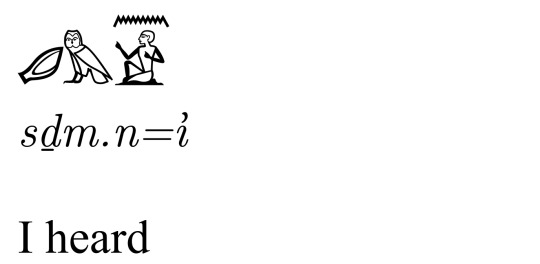
You see the 'n' sign above the pronoun =i ? That's the .n of the past! It tells us that the verb preceding it, in this case sDm 'to hear', is being read as the past tense and thus we have to translate it with the -ed past tense ending in English. Yes, it does look very similar to the 'n' pronoun for 'we' (=n) and the preposition for 'to/for (a person)' (n). It's because they are all the same sign, they're just being read in different ways.
What do all the .'s, ='s, and brackets mean in transliteration?
So as I just showed you, the marker of the past tense is denoted with the water sign 'n' which is attached to a verb in transliteration using .n at the end. You've also seen me use the equals sign with the pronouns like =i. In Egyptology, at least, we use these symbols as a way to differentiate between different markers of grammar and basically make it easier to spot when we're just reading someone else's work. Say you've got sDm.n=n mdw r=k 'we heard the words concerning you'. Here are the glyphs:

You can see that sDm is easy to see (the ear reading sDm, and the owl reading m as a phonetic complement, forming the word) and then you've got two water symbols for n, and three vertical strokes. Now, as I've already shown you, the n of the past tense, and the n that's the pronoun for 'we' look pretty much the same, but you know they're different. However, when they're together in one sentence it makes them difficult to distinguish. In order to make them distinct when transliterating we use .'s for marking the endings of verbs be they tense markers or say the feminine .t ending. For pronouns we use ='s so that it's clear they're separate from both the verbs and grammar markers. Otherwise you'd end up with sDmnn mdw rk and it would really tell you absolutely nothing if you were reading it without the glyphs.
I should note at this point that some schools of Hieroglyph teaching use the . for both the verb ending marker and for the pronoun. So it'd look like sDm.n.n and that would be completely fine. I didn't learn this way, so I won't be using it. I'm just mentioning it here for the sake of completeness.
For brackets, I'll do a quick run through: … denotes a lacuna (a hole in the text) with no restoration, [ ] denotes a lacuna with restoration, < > denotes an omission made by the original scribe, whether intentional or accidental, and ( ) denotes a modern addition, usually in the translation to give proper English sense or to provide clarification. In cases where an Egyptian word is legible but the meaning is unclear, ___ denotes an unknown transliteration and a (?) denotes an uncertain translation.
How do you know where a word stops and another one begins?
Ahh the classic! This is a two parter: the first part is 'usually there's a sign that tells you' and the second part is 'more experience with hieroglyphs.' With experience you tend to learn how the most common words are formed, so you know what those look like and how they're spelt. This means that you tend to be able to pick those out of a sentence, and whatever is left must be a word/s you don't know. Over time you'll begin to realise what signs do and do not form words, so if you're trying to read a word and it doesn't make any sense you probably need to separate the signs you're looking at. It really is just practice and becoming more familiar with the language.
The other way, is learning how to spot what are called 'determinatives'. A determinative is a sign that helps to categorise a word without having any consonantal value. It’s just there at the end of a written word, like a man with hand to mouth at the end of the word ‘vomit’ in Egyptian tells the reader (most of whom were illiterate) that the word had something to do with something that comes from the mouth). Not every determinative has the same value as the word it’s written for, and some can even be metaphorical in nature. If I bring back the first sentence I used in this post 'You hear a cat' I can show you what a determinative looks like:
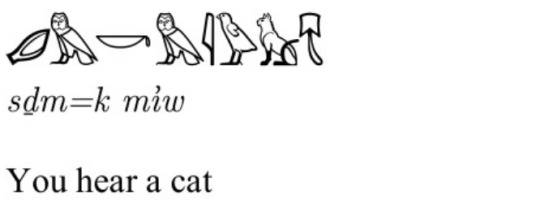
Since you know that sDm is the verb 'to hear' and =k is the pronoun for 'you', then miw must be the word for 'cat'. But there are 5 signs and only 3 consonant values in miw, which ones are we reading? The answer is the first three signs: the m 'owl' the i 'reed leaf' and the w 'quail chick'. So what about the last two signs: the seated cat and the pelt? Well those are the determinatives I told you about. They're part of the word, but they don't have any sound values. They're just there to tell us that the word is about a cat (seated cat!) and an animal (pelt!). Now I could have written the word miw 'cat' with just the seated cat sign, as that by itself has the 3-consonantal value of miw, but here, along with the pelt, it's just being used as a way to reinforce to the reader that this word is animal based and that animal is a feline.
It also helps that words in Egyptian tend to have no more than 2 or 3 consonants in them (some have 4, but they're not as common). So if you're transliterating and you've got a word you don't know that appears to have more consonants in it...you might want to take a look at it because you've probably added two words together, or joined the past tense marker or pronouns into the word you're looking at. In fact, knowing the grammar markers, and the pronouns, and what a determinative looks like is what helps you pick out the words more easily. It's sort of a process of elimination of words/grammar you do know, to see what's left and that's where you get the dictionary out and start looking things up.
I'm going to try my best here to show this in diagram form. Ideally, this would be done in person where I could write it on a board and go through it in real time, but since I can't do that I'll have to go with this:

This is an excerpt from the 'Dialogue Between a Man and His Ba' and you're looking at it going 'oh dear god'. So let's start by marking out where our words separate in blue:

So, these are all the words within this sentence, and I hope it at least shows you where the transliteration is following. However, how do I know this? You can see the pronouns in the transliteration marked with the ='s sign. I'll mark those in pink:
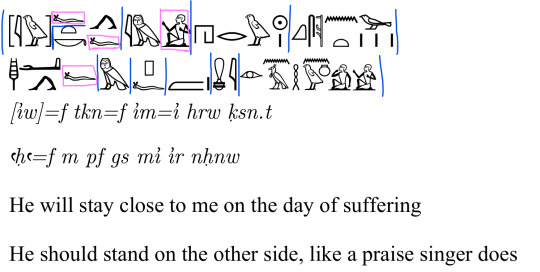
So you can see for four words in these two sentences they end with either the =f 'he' (second person masc.) or =i 'I' (first person masc.) pronouns. Those suffix pronouns only come at the end of words, so those must be the ends of those words, and what comes before is the word. Cool. So, what about determinatives in these sentences? Can seeing them help us see the end of any other words? I've marked them in green:

So, now you can see where the determinatives are. The walking legs determinatives noting a verb of 'motion' appear twice before pronouns, and that's fine, they're marking the end of the word where the pronoun goes anyway! Some of them don't though! The first set that don't are the Ra 'sun' symbol and the single stroke, which are determinatives for the word hrw 'day'. These determinatives are a) showing that the word hrw has something to do with the sun (passing of time), and there's only one of them (hence the single stroke). Thus we know this means 'day'. The next is the bird and plural strokes at the end of qsn.t 'suffering'. Plural strokes don't usually come in the middle of a word, so that helps us to identify the end of a word quite easily. The bird is what's known as the 'bin' or 'bad bird', which turns up as the determinative for words that have bad connotations (not always being used in a bad way though). In this case we have the word 'suffering', so the bad bird is here to tell us that. With those two together, it tells us this is the end of the word qsn.t. After the word 'gs' (meaning 'side') you can see I've highlighted the single stroke determinative. This is because that sign can also be read as 'm' like the owl sign in the sentence before it, and what they're using this sign to denote is that 'hey we're not dealing with a preposition here this is a noun!'. The last set are from the word nHnw 'praise singer'. You have the man with his hand to his mouth indicating that the word is something that comes from the mouth (in this case singing), and then the seated man is not a pronoun (this is one of those cases where you'll have to watch out in your translations!) but another determinative telling us that this is a 'person' word i.e. someone who does the action. Thus we translate it as 'praise singer' rather than 'praise singing'.
There are no tense markers, like the past, in these sentences so I'll skip that. There is another grammar marker of the .t ending in qsn.t, but that would require explaining an entirely different verb form and no one is here for that. I'm just noting it's there for people who can read this and are like 'girl there's one right there!' I know and I'm choosing not to perceive.
Anyway, the last things to look at are prepositions and particles. Do we have any of those in these sentences that could help us identify where words begin/end? I've marked prepositions in red and particles in yellow:
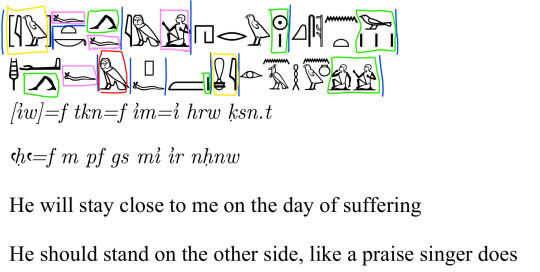
So we have one preposition and it's the preposition 'm' in/from. So we know, thanks to the pronoun before it that it doesn't belong to that word, and since 'm' as a preposition is a single sign, it can't belong to the next signs. Then we have the two particles. One is right at the start and is the 'iw' particle that has no written meaning. It's at the beginning, so we know that this is the opening to a clause and therefore the signs that precede it in the text (which aren't shown here) don't belong to it. The pronoun attached it is the 'he' at the beginning of the clause. The other =f pronoun attached to tkn is what's known as a resumptive pronoun, meaning it's there for emphasis but isn't read in translation.
The other particle is 'mi' 'like', which comes after a determinative stroke for 'gs' (side), and before a lot of signs that end in the two men (hand to mouth and seated). So we know that if 'mi' is a particle by itself, it doesn't belong to the signs that come after it, and therefore is its own word. If you tried to read it with the other words, you'd get miirnHnw and since we know that Egyptian words tend to be 2-3 consonants long, with a max of 4, this is too long to be an actual word. Therefore mi has to be separate from ir and nHnw.
There's another little bit of grammar I didn't cover, because 'too advanced for this post', but for completionist's sake: there's another type of pronoun in here called a demonstrative pronoun. In English it's what the words 'this/that' are referred to. Here the word 'pf' (the sign group with the rectangular box and the horned viper) is performing that function meaning 'over there'. So in the sentence we have: aHa=f 'he should stand' (subjunctive + second person masc.), m 'on' (preposition), pf 'the other' (demonstrative pronoun), gs 'side' (noun), mi 'like' (particle), ir 'does' (infinitive verb), nHnw 'praise singer' (noun). If that makes sense? It probably doesn't, but that's how we know pf isn't connected to either m or gs. Somewhere my lecturers are feeling a weight lifted from them and it's because I'm finally able to express this without confusion. Sadly they'll never see it lmao.
So what do we have left unmarked? Those are all your verbs, nouns, and adjectives! tkn (stay close), hrw (day), qsn.t (suffering), aHa (stand), ir (does), nHnw (praise singer). Once you remove all your grammar markers what you're left with can only be those three. The only one that isn't clearly marked is 'ir', and that's because it tends to just show up as the eye sign, or the eye sign with an r 'mouth' sign beneath it. Here it's just the eye sign, and an inexperienced reader will likely either read it with the particle 'mi' making miir, or with nHnw making irnHnw. Either way they're going to run into some issues, and unfortunately the only way they'll stop making that mistake is experience with translating MEg.
I hope that this post has at least somewhat cleared up the confusion about how Hieroglyphs and Middle Egyptian work. If I'm honest, I think it's more likely to have confused some of you even more. I apologise for that. Trying to explain a dead language, for which most of you have no reference point, on a medium like tumblr is pretty difficult. If what I've said here is too complicated, I would suggest getting yourself a copy of Mark Collier's 'How to Read Egyptian Hieroglyphs'. That book is about £10, and it's really easy to get hold of. The British Museum shop has copies you can buy (it got a reprint thanks to the Hieros exhibit) and I know it's on Amazon too. Go forth and get the book written by the man who taught me how to read them! sorry Mark
Congrats on reaching the bottom of 'Do you know how to read hieroglyphs? Which one?'
𓋹𓍑𓋴 ꜥnḫ wḏꜢ snb
#scheduled#this took me the best part of a week (over several evenings) to write and create all the hieroglyphs for
651 notes
·
View notes